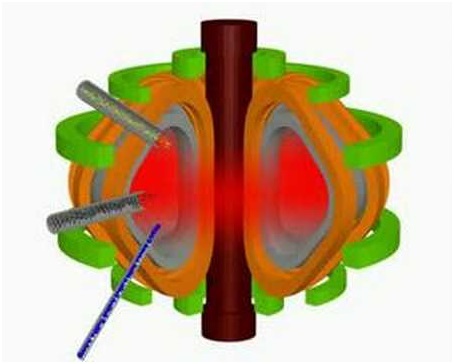In 1991, Small Tight Aspect Ratio Tokamak (START) experiment was started at Culham, a village near Abingdon in Oxfordshire, U.K. One of the innovations of START was to shrink the aspect ratio of the reactor from the older race track tokamak design to a more spherical shape. It ultimately achieved a record ratio of plasma pressure to magnetic field pressure of forty percent (this ratio is called the beta of the reactor). START utilized a neutral beam injector. This approach consists of injecting a stream of neutral atoms (deuterium in START) into the center of the plasma to assist in heating it.
In 1992, the Engineering Design Activity for the International Thermonuclear Experimental Reactor began following the Conceptual Design Activity for the International Thermonuclear Experimental Reactor which had started in 1988. Euratom, Japan, Russia and the United States are involved in the ITER project.
In 1993, the Experimental Tokamak Fusion Test Reactor (TFTR) at Princeton Plasma Physics Laboratory in New Jersey began testing a mixture of fifty percent deuterium and fifty percent tritium. Later, the TFTR managed to produce ten megawatts from a controlled fusion reaction. It was hoped that the TFTR would ultimately be able to reach the break-even point where more energy was produced than was consume but it was never able to reach break-even.
In 1994, the National Ignition Facility at the Lawrence Livermore National Laboratory completes work on the Beamlet laser which was started in 1990. This laser was designed and constructed to act as a test bed for the development of lasers for fusion research. A comprehensive study of Heavy Ion Fusion called the Heavy Ion Driven Inertial Fusion Study is undertaken in Europe at the Gesellshaft für Schwerionenforschung. The project includes work in fourteen laboratories including labs in the U.S. and Russia.
In 1996, the French Tora Supra tokamak achieves a record two minutes plasma confinement. This included about one million amperes of induced current driven by lower hybrid frequency waves. Active cooling the components that faced the plasma in the tokamak made this possible and helped pave the way for the active control of steady state plasma discharges.
In 1997, the Joint European Torus in the UK generates sixteen megawatts of power from fusion processes which represented a world record for power generation from fusion. The Lawrence Livermore National Laboratory conducts a study of the projected costs of different fusion sources in an attempt to estimate future energy generation costs. They concluded that Heavy Ion Fusion reactors should cost more than a natural gas generator but less than a new fission reactor. A ceremony is held for ground-breaking for the National Ignition Facility (NIF) at the Lawrence Livermore National Laboratory. The NIF is the biggest and most powerful inertial confinement fusion device ever built. Powerful lasers heat and compress a tiny hydrogen pellet to ignite a fusion reaction. A new fusion concept called Magnetized Target Fusion is explored in the U.S. A field-reversed pinch is combined with an imploding magnetic cylinder in this approach. A low density plasma device is compressed explosively with techniques developed for high-speed gun research.
START design for a tokamak:
